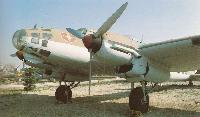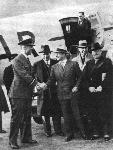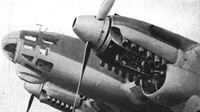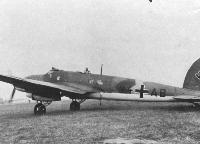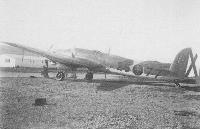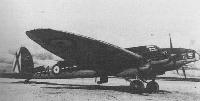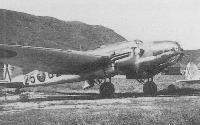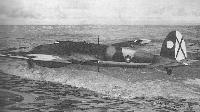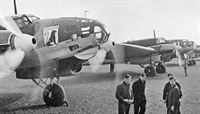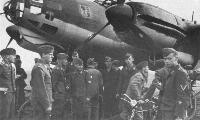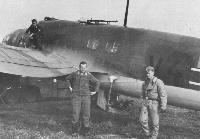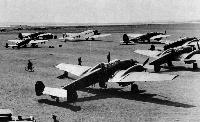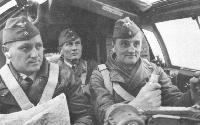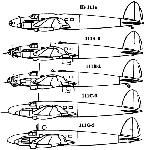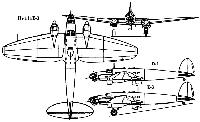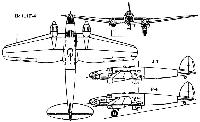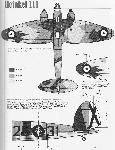
Варианты
- Heinkel - He-111 - 1935 - Германия
- Heinkel - He-111P/H - 1938 - Германия
- Heinkel - He-111Z Zwilling - 1941 - Германия
- CASA - 2-111 - 1943 - Испания
He-111
Средний бомбардировщик, двухмоторный цельнометаллический моноплан. Шасси убирающееся, с хвостовым колесом. Экипаж 4 - 6 чел. Создан в КБ фирмы "Эрнст Хейнкель флюгцойгверке" под руководством З.Гюнтера, В.Гюнтера и К.Шварцлера. Опытный образец Не 111a совершил первый полет 24 февраля 1935 г. Серийное производство началось весной 1936 г. Не 111 выпускался на заводах "Хейнкель" (Росток, Берлин), "Норддойче Дорнье верке" (Висмар), ATG (Лейпциг), "Арадо флюгцойгверке" (Бабельсберг, Бранденбург-Хавель), "Фабрика де авион SET" (Бухарест). По лицензии выпускался также фирмой CASA в Испании (завод в Табладе). В общей сложности построено свыше 7300 экз. (без учета производства в Испании).
Состоял на вооружении в Китае с конца 1936 г., в Германии - с января 1937 г., в Испании - с августа 1938 г., в Турции - с октября 1937 г., в Румынии - с осени 1940 г.
Основные серийные модификации:
- He 111A с моторами BMW VI 6.0Z, вооружение 3x7,9, бомбы до 1000 кг;
- He 111B с моторами DB600Aa/CG, вооружение 3x7,9, бомбы до 1500 кг;
- He 111E с моторами Jumo 211A-1, вооружение 3x7,9, бомбы до 2000 кг;
- He 111F с моторами Jumo 211A-3 и новым крылом, вооружение 3x7,9;
- He 111J с моторами DB 600CG, бомбардировщик-торпедоносец на базе модификации F;
- He 111P с моторами DB601Aa/N, вооружение от 3x7,9 до 6x7,9, новая асимметричная носовая часть;
- He 111H, аналог Не 111P с моторами Jumo 211A/D/F, большое количество вариантов разного назначения (бомбардировщики, торпедоносцы, носители самолетов-снарядов и управляемых бомб и т.д.) с вооружением до 1x20+1x13+ 8x7,9 (H-11/R1).
Не 111 впервые были применены в боях под Шанхаем в 1937 г. С февраля 1937 г. по март 1939 г. они участвовали в гражданской войне в Испании на стороне франкистов. С сентября 1938 г. Не 111 - самый массовый бомбардировщик Люфтваффе. Использовался в сентябре 1939 г. в Польской кампании, с сентября 1939 г. участвовал в налетах на Англию, в Норвежской и Французской кампаниях, в "битве за Англию" (1940 г.)- В мае 1941 г. они поддерживали мятеж Рашида-Али в Ираке (летая с иракскими опознавательными знаками из Сирии), в июне бомбили приграничные районы СССР. С осени 1941 г. Не 111 постепенно вытеснялся более современным Ju 88. Последняя крупная операция Не 111 в Советском Союзе - налеты на американские базы на Украине в июне 1944 г., на Западном фронте - действия Не 111H-22 (носителей самолетов-снарядов V-1) против городов Англии.
Румынские бомбардировщики применялись в войне против СССР с июня 1941 г. до 1944 г., далее - в операциях против немцев.
Не 111 снят с производства в Германии осенью 1944 г. Испанские С 2.111 выпускались в 1945 - 1956 гг.
Описание:
- He-111
- He-111J/H-6/T
- Heinkel He 111
- Flight, January 1936
A 254 m.p.h. HEINKEL
Фотографии
-
Авиация и Время 2007-05 / А.Демин - Воздушные драконы Поднебесной (2)
Heinkel He 111A-1 из 19-й ТБАЭ ВВС Китая. Нанчань, осень 1937г.
-
АвиаМастер 2004-03 / А.Заблотский, Р.Ларинцев - Сигнал Orlog: Крушение сталинградского "воздушного моста" /На фронтах Великой Отечественной/
Самолет - участник сталинградского "воздушного моста": "Хейнкель" He 111E из состава одной из транспортных групп Люфтваффе (KGrzbV 5 или KGrzbV 20).
-
Air Enthusiast 1998-09 / G.Cruz - Pegqenos and Grandes
He 111E-3, assigned to 15 Regimiento. Tail-mounted serials are almost invisible in the extant pictures, but after research the Author has found out that this aircraft was B.2-88. Accordingly, the serial has been positioned where it was supposed to be carried.
-
Air Enthusiast 1998-09 / G.Cruz - Pegqenos and Grandes
H 111J-1 ‘25-101’ (later MB.2-101), assigned to 92 Escuadrilla Meteorologica. The aircraft sports a mixture of civil (national flag) and military (fuselage code) markings. ‘Yoke and arrows’ were carried on both civil and military aircraft at the time. Drawing based on recently unveiled photographic material, taken in 1943 at Bordeaux-Merignac by KG 40 personnel.
-
Мировая Авиация 163
58 из 75 самолетов He 111B/E, направленных в легион "Кондор", пережили гражданскую войну и оставались в Испании в эксплуатации у 14-го и 15-го авиаполков испанских ВВС. Часть машин - как этот He 111E-1 - находились в эксплуатации до конца 1950-х годов.
-
Air Enthusiast 1998-09 / G.Cruz - Pegqenos and Grandes
The He 111E-3 preserved at Cuatro Vientos, near Madrid. Sadly, there are many inaccuracies in its basic finish, both the extent of the camouflaged zone and the way the brown and green colours were applied are incorrect. The shape and dimensions of the markings are also not particularly accurate. The nose emblem seems to he that of 2.K/88. The Author doubts that the fuselage code ‘25-82’ was ever worn by this aircraft. A logbook for the original ‘25-82’ shows the aircraft’s w/nr was 5240, while the museum example has a ventral identity plate proclaiming w/nr 2940.
-
Air Enthusiast 1998-09 / G.Cruz - Pegqenos and Grandes
The previous colour scheme employed on the Cuatro Vientos He 111E-3. With fuselage code ‘14-16’ and fin-mounted serial ‘B.2-82’ with white outline.
-
Jane's All the World Aircraft 1938 / 03 - All the world's aeroplanes
Регистрационный номер: D-AQUA The Heinkel He.111 Ten-passsenger Commercial Monoplane (two 1,070 h.p. Daimler-Benz DB.600 engines).
Heinkel He 111C D-AQUA believed to be the original prototype bomber after conversion to transport configuration. Note the curved leading and trailing wing edges. -
Aeroplane Monthly 1985-06 / J.Stroud - Wings of Peace
Регистрационный номер: D-AXAV [2] The characteristic silhouette of the Heinkel He.111 of Lufthansa.
The view emphasises the attractive elliptical wings of the He 111. This example is He 111C-03 D-AXAV. -
Aeroplane Monthly 1985-06 / J.Stroud - Wings of Peace
A Lufthansa He 111C-0 approaches with flaps and undercarriage lowered.
-
Flight 1939-04 / Flight
COMING IN: The machine shown about to land with flaps and wheels lowered is Heinkel He 111
-
Aeroplane Monthly 1985-06 / J.Stroud - Wings of Peace
Регистрационный номер: D-ASAR [3] D-ASAR, the He 111G-4 used by Erhard Milch, seen at Croydon.
-
Air Enthusiast 1998-05 / K.Wixey - Triple One Lineage (1)
Регистрационный номер: D-ASAR [3] He 111V16 D-ASAR, fourth in the ‘G’ series, became personal aircraft of Field Marshal Erhard Milch, a founder of the clandestine Luftwaffe in the early 1930s.
-
Air Enthusiast 1998-05 / K.Wixey - Triple One Lineage (1)
Регистрационный номер: D-AHAO [2] Heinkel He 111V4 D-AHAO ‘Dresden’, was the second commercial prototype.
-
Flight 1936-01 / Flight
Регистрационный номер: D-AHAO [2] D.L.H. SPEED UP: The new twin-engined Heinkel, which has a top speed of 214 m.p.h. With more powerful engines, as will be fitted to a batch of the machines expected to go into service this summer, over 254 m.p.h. is hoped for, with a cruising speed of 217 m.p.h. It is fitted with flaps and a retractable undercarriage.
-
Мировая Авиация 64
Регистрационный номер: D-ALES 24 февраля 1935 года совершил первый полет якобы гражданский прототип самолета Heinkel Не 111 а (позже Не 111 V1). Было очевидно, что самолет представляет собой бомбардировщик (на снимке - второй прототип бомбардировщика Не 111b).
-
Aeroplane Monthly 1985-06 / J.Stroud - Wings of Peace
Регистрационный номер: D-ABYE Пассажирский Не 111C-02 авиакомпании "Люфтганза"
He 111C-04 Konigsberg at Tempelhof. -
Aeroplane Monthly 1985-06 / J.Stroud - Wings of Peace
Регистрационный номер: D-ALIX [2] D-ALIX, the He 111c transport prototype, runs up its engines against the chocks.
-
Мировая Авиация 163
Регистрационный номер: D-ALIX [2] He 111C над самолетами компании "Luft Hansa", среди них есть и прототип He 111c.
-
Flight 1937-02 / Flight
A Deutsch Luft Hansa Ju.52 and Heinkel 111 at Tempelhof.
Другие самолёты на фотографии: Junkers Ju.52/3m - Германия - 1931
-
Flight 1938-01 / Flight
Регистрационный номер: D-AXAV [2] Signalling-out an He.111 with an indicator of the type used on railways. Note the official's armament.
“An efficient member of the tarmac staff ... might well be supplied, as is the fairly common practice abroad, with a suitable flag or light metal disc on a wooden handle, clearly marked with the letter 'C,' indicating Control." -
Мировая Авиация 163
Данный He 111 V14 получил в "Luft Hansa" обозначение He 111C и имя "Augsburg".
-
Flight 1936-01 / Flight
With its present 660 h.p. engines the new Heinkel has a top speed of 214.37 m.p.h.; Over 254 m.p.h. is expected when the 880 h.p. units are fitted.
-
Мировая Авиация 163
Регистрационный номер: D-AQYF [4] Коммерческие варианты. Хотя "Heinkel" сконцентрировалась на создании самолета военного назначения, He 111 был востребован и как авиалайнер. Второй прототип, He 111c (D-ALIX, "Rostock"), был достроен именно как авиалайнер и затем передан "Luft Hansa". Четвертый прототип He 111 V4 был также гражданским вариантом, равно как и шесть He 111C-0 (фото), поступившие в "Luft Hansa" в 1936 году. Самолеты использовались преимущественно на скоростных маршрутах между немецкими городами и оказались весьма неэкономичными, хотя и эксплуатировались вплоть до окончания войны. Еще четыре самолета поступили в "Luft Hansa" как He 111G, два из них оснащались двигателями BMW VI 6,0 ZU, а два - звездообразными BMW 132H-1. Большинство He 111C/G авиакомпании были реквизированы Люфтваффе.
-
Aeroplane Monthly 1985-06 / J.Stroud - Wings of Peace
Регистрационный номер: D-AQYF [4] Lufthansa’s He 111C-02 D-AQYF at Tempelhof.
-
Aeroplane Monthly 1985-06 / J.Stroud - Wings of Peace
Регистрационный номер: D-AQYF [4] A closeup of the ten-passenger He 111. The engines are B.M.W. vee-twelves of either 660 or 880 h.p.
A close-up of D-AQYF, the He 111C-02. This aircraft, named Leipzig, was one of a batch of six completed from the summer of 1936. -
Flight 1937-02 / Flight
Регистрационный номер: D-AQYF [4] International convention at Tempelhof - Heinkel He.111, Junkers Ju.52, Danish Fokker, French Wibault, and others.
Другие самолёты на фотографии: Fokker F.IX / F.XII / F.XVIII - Нидерланды - 1929Junkers Ju.52/3m - Германия - 1931Wibault Wibault 280 - Франция - 1930
-
Flight 1937-10 / Flight
Регистрационный номер: D-ASAR [3] In civilian dress: The arrival of our German guests at Croydon at the beginning of the week. General Milch is being welcomed by A.V.-M.R.E.C. Peirse. General Wenninger, German air attache, is in front of the cabin door of the Heinkel He.111.
-
Мировая Авиация 163
Первый прототип He 111a поднялся в воздух с аэродрома компании "Heinkel" в Росток-Маринее 25 февраля 1935 года, пилотировал его Герхард Нитшке. Самолет построили в варианте бомбардировщика.
-
Flight 1938-12 / Flight
The installation of two Daimler Benz D.B.600 inverted vees in a Heinkel bomber of the German Air Force. An engine of this type is exhibited at Paris.
-
Air Enthusiast 1998-05 / K.Wixey - Triple One Lineage (1)
He 111B-1 bomber, note the stepped cockpit, nose glazing/bomb-aimer’s position and ‘passenger’ windows!
-
Jane's All the World Aircraft 1938 / 03 - All the world's aeroplanes
The Heinkel He.111K Twin-engined Bomber (two 1,070 h.p. Daimler-Benz DB.600 engines).
-
Flight 1939-03 / Flight
A close-up of one of the sleek He.111s now in service in large numbers with the German Air Force. This machine must be one of the most formidable of its class in the world.
The Heinkel He 111K with two Daimler Benz DB 600 engines is believed to equip a large proportion of Germany’s bombing force. -
Air Enthusiast 1998-05 / K.Wixey - Triple One Lineage (1)
Heinkel He 111B-1 as used by two staffeln of KG88 in the Spanish Civil War during 1937.
-
Air Enthusiast 1998-05 / K.Wixey - Triple One Lineage (1)
Регистрационный номер: D-AYFO Carrying civil registration D-AYFO, a Luftwaffe He 111B-1 with DB600 engines, showing off the type’s early style wing planform.
-
Мировая Авиация 155
Бомбардировщиками He 111E-1 с моторами Jumo и с 2000-кг бомбовой нагрузкой, в конечном счете, оснастили четыре эскадрильи подразделения K/88.
He 111E-1 ‘V4+EH’ with Jumo 211A-3 engines and all-internal bomb load. This version flew operationally in Spain during 1937 with the four bomber staffeln of KG/88. -
In Action 1006 / Heinkel He111 in Action
V4 + AB, an He 111F-4 of Kampfgeschwader 1, "Hindenburg", picks up speed for takeoff on another visit to the Polish Army. The ventral "dustbin" has been fully retracted into the belly for takeoff. When the Heinkel was in flight, a fully lowered "dustbin" caused enough drag to slow the plane about 20 m.p.h. The F version was phased out of the Luftwaffe's bomber inventory shortly after the start of the Polish campaign, but continued to remain in service for a time as a crew trainer and armed VIP transport.
-
Aviation Historian 25 / G.Baughen - The case for appeasement?
The bomber that would become a symbol of German air power above all others was the Heinkel He 111, which initially had a conventional “stepped” nose arrangement, as seen here, before the much better-known, and rather more sinister, fully glazed nose was introduced on the He 111P and retained on all subsequent variants.
-
In Action 1006 / Heinkel He111 in Action
A Heinkel He 111B-2 bomber rests in front of its hangar. The B-2 was one of the first of the Heinkel He 111s to see combat action during the Spanish Civil War. This particular bomber bears the markings and camouflage pattern of the Luftwaffe, circa 1937. The large swastika on the vertical tail surfaces of the plane is set against a bright red horizontal stripe.
-
Air Enthusiast 1998-05 / K.Wixey - Triple One Lineage (1)
Регистрационный номер: D-AOHA Production He 111D-1 D-AOHA, with ventral radiators and DB600Ga engines. The ventral gun ‘dustbin’ is lowered.
-
Авиация и Космонавтика 2025-02 / В.Хвощин - Видеть дальше "буратиньего носа" (4)
Первоначальная форма раннего варианта носовой части фюзеляжа с отдельной кабиной штурмана на бомбардировщике Heinkel He 111J
-
Flight 1938-02 / Flight
Регистрационный номер: D-AFAY [2] Military-type He.111 medium bombers which must do nearer 300 than 250 m.p.h.
-
Air Enthusiast 1998-05 / K.Wixey - Triple One Lineage (1)
Регистрационный номер: D-AFAY [2] Line-up of He 111B-1 bombers in 1937. They feature DB600 engines and still carry civil registrations.
-
Air Enthusiast 1998-09 / G.Cruz - Pegqenos and Grandes
Although the tail serial is not visible in the picture, ‘15-8’ was B2-99, the highest-serialled former Legion Condor aircraft taken over by the Spain. Pictured in the early 1950s (very probably 1952) at Agoncillo where the Regiment was based. Note the almost brand new-looking appearance of this aircraft, as late as 1952! By this time, the dark green tone (RLM 62) was often over painted dark brown (RLM 61), explaining why many aircraft wore a non-standard two-tone scheme.
-
Мировая Авиация 163
Первым в 1936 году в 154-ю бомбардировочную эскадрилью на вооружение поступил вариант He 111B. В феврале 1937 года He 111B попали в Испанию, а 9 марта 88-я боевая группа применила их в бою.
A Heinkel He 111B-2 serving with the Legion's Kampfgruppe 88. -
Air Enthusiast 1998-09 / G.Cruz - Pegqenos and Grandes
‘25-31’, one of the 113 Grupo He 111B-1s, at Son San Juan air base during the spring of 1942. Note the three-tone splintered camouflage worn by the aircraft, which differed from one example to another. Noteworthy, too, are the uniforms worn by the two second lieutenants in front of the aircraft, typical of that period.
-
Air Enthusiast 1998-09 / G.Cruz - Pegqenos and Grandes
At Agoncillo soon after the Civil War’s end, ‘25-77’ wearing larger fuselage code numbers and black circle - with red ‘yoke and arrows’ Falangist emblem on it. The three-tone ‘splintered’ camouflage is evident.
-
Air Enthusiast 1998-09 / G.Cruz - Pegqenos and Grandes
He 111E - serial unknown - at Matacan in the markings of the Escuela Superior de Vuelo or ESV (High Flying School), where the type served in the navigational and blind flying training for at least ten years.Coded ‘74-15’, lettering in the tail reads ‘Escuela Superior de Vuelo’. A yellow flash - that together a brown owl badge formed the school’s distinctive markings and were carried by most of its aircraft - can be seen along the fuselage.
-
Air Enthusiast 1998-09 / G.Cruz - Pegqenos and Grandes
He 111E-3 w/nr 5240, ‘25-82’, was first issued to the 14 Regimiento, later transferred to the 15 Regimiento in 1951. It ended its operational life on December 16,1956. Noteworthy is the Civil War-style St Andrew’s cross still worn by the aircraft in the background. The He 111E-3 preserved at Cuatro Vientos carries the codes ‘25-82’.
-
Air Enthusiast 1998-09 / G.Cruz - Pegqenos and Grandes
One of He 111Es turned over by the Legion Condor to the Nationalists, ‘25-81’ was first issued to the 14 Regimiento. Illustrated soon after the Spanish conflict, hence full wartime markings. Note the emblem of 2.K/88 and the absence of the ‘yoke and arrows’ in the Black circle of the fuselage.
-
Air Enthusiast 1998-09 / G.Cruz - Pegqenos and Grandes
Line-up of He 111Es awaiting delivery to the Arma Aerea Espanola, shortly after the end of the Spanish Civil War. Nearest is ‘25-96’, one of the last He 111Es delivered to the Legion Condor. It (and very likely the other five) still wear wartime unit markings.
-
Air Enthusiast 1998-09 / G.Cruz - Pegqenos and Grandes
He 111E-70 ‘14-17’, during one of the last exercises it took part in, 1956. Note non-standard red-black spinners.
-
Air Enthusiast 1998-09 / G.Cruz - Pegqenos and Grandes
<...> to advantage the three-tone camouflage scheme, ‘25-93 ’ (w/nr 1342) in 1941, still wearing wartime markings, despite having been<...> to the 15 Regimiento. Tail marking is likely to be part of a Legion Condor emblem.
-
Мировая Авиация 99
Прибытие Не 111 (на снимке) и Savoia-Marchetti S.M. 79 в Испанию положили конец недолгому господству в воздухе республиканских СБ-2.
-
Air Enthusiast 1998-09 / G.Cruz - Pegqenos and Grandes
Although the Civil War had ended eight months before, an He 111B-2 still wearing wartime markings in December 1939. Note what seems to be a two-tone non-standard camouflage scheme.
-
История Авиации 2001-03 / В.Котельников - Незаконнорожденный бомбардировщик /Самолеты страны советов/ (4)
Проходивший испытания в НИИ ВВС под обозначением "самолет 31" немецкий трофейный He111B был захвачен в Испании летом 1937г. Также как и ДБ-3 на немцев, "Хейнкель" не произвел на советских специалистов никакого впечатления своими летными данными, но отдельные технические решения (например носовую огневую точку и потайную клепку передней части фюзеляжа) решено было использовать на отечественных машинах.
-
Мировая Авиация 163
He 111F отличался новым крылом, благодаря чему удалось упростить серийный выпуск самолетов. Турция приобрела 24 самолета He 111F-1, поставленных в 1938 году и эксплуатировавшихся до 1946 года.
-
Air International 1988-02 / Talkback
Two Heinkel He 111F-0s of the TUAF (Turkish Air Force).
-
Мировая Авиация 163
В марте 1938 года 45 самолетов He 111E были направлены в легион "Кондор" в Испанию, где они присоединились к поставленным ранее He 111B. Летали на них как немецкие, так и испанские летчики.
-
Aviation Historian 25 / G.Baughen - The case for appeasement?
The Munich Agreement was signed by Germany, France, Italy and Britain on September 30, 1938, and by the summer of 1939 the Luftwaffe was arguably the most technologically advanced air force in the world, with 11 bomber wings prepared for combat, including KG 26, formed in May 1939 with He 111Fs, as seen here that year.
-
Flight 1939-09 / Flight
Heinkel He 111s of the Luftwaffe seen on arrival in Prague last March. At this time Field Marshal Goering announced the formation of a new air command based on Vienna.
-
Моделист-Конструктор Бомбардировщики Второй мировой войны
Не 111E-1 из эскадрильи 2.К/88 "Легиона Кондор" в Испании, 1938 г.
-
In Action 1006 / Heinkel He111 in Action
The command flight crew of Kampfgeschwader 1 gathers to hold a brief conference before takeoff. Ground crewmen are busy topping off the fuel tanks in the wings of the Heinkel, while others polish up the outside of the windshield glass. It is interesting to note that the officers of the flight crew are wearing their Sam Browne belts over their flight coveralls, a practice that was discontinued , later on in the war because of the uncomfortablilty of the belt.
-
In Action 1006 / Heinkel He111 in Action
Luftwaffe anti-aircraft (Flak) gunners receive a tour of an airbase flight line and a close inspection of an He 111F bomber. They are probably being instructed on recognition factors of the He 111, as it wasn't uncommon for gunners to shoot down their own planes from time to time because of poor recognition. Three distinct types of Luftwaffe uniform can be seen. The Flak gunners all wear the standard blue-grey jackets and pants tucked into their boots. Two wear the black loose-fitting coveralls of ground crewmen, while two other airmen (one running) wear the khaki flight coveralls over their blue-grey uniforms.
-
In Action 1006 / Heinkel He111 in Action
A Heinkel He 111F-4 bomber of Kampfgeschwader 1, bearing the coat of arms of Field Marshal Hindenberg's family rolls slowly out on to an East German runway just prior to the beginning of the Polish campaign. The crewman with his head and shoulders out of the top of the canopy is in the process of guiding the pilot on to the runway. The long, narrow nose of the F-4 obstructed the pilot's downward and forward vision considerably when the tail of the airplane was on the ground. Using another person to help the pilot when taxiing became a standard practice for He 111 crews of the Legion Condor during the Spanish Civil War and continued until the Heinkel's nose was radically modified in 1939 with the introduction of the He 111P series.
-
In Action 1006 / Heinkel He111 in Action
Servicing a Heinkel He 111F-4 bomber of KG 1 for another combat mission. The Luftwaffe armorer on the left stands with a 110 pound SC50 bomb. To the right another armorer stands with part of the bomb hoist block and tackle assembly which will later be hooked up into the heart of the bomb bay to aid in hoisting the bombs into position. The ventral, or belly "dustbin" machine gun position can be seen extended almost to the ground beneath the fuselage.
-
In Action 1006 / Heinkel He111 in Action
A Luftwaffe armorer seats the hand-held MG 15 nose machine gun into it's receptacle in the middle of the nose bubble. The MG 15 was simply a modified version of the infantry's MG 34 7.92mm machine gun. Plainly visible is the fairing under the nose through which the lens aperture for the bomb sight was fitted when in use.
-
Мировая Авиация 163
Какое-то время на модификации He 111D, E и F устанавливались моторы Jumo 211, компания-производитель затем вновь вернулась к двигателям DB 600 - именно они стояли на Не 111J, поставленных Люфтваффе в количестве 90 машин летом 1938 года.
Торпедоносцы Не 111J из группы KGr 806 -
In Action 1006 / Heinkel He111 in Action
While a ground crewman squats on the wing to oversee the refuelling of the bomber, the dorsal and belly gunners pose for the photographer. One of the two gunners already has on his flight coveralls, while the other still wears his standard blue-grey Luftwaffe uniform. A close look will reveal the "dustbin" belly position partially extended below the fuselage. This position mounted a single MG 15 machine gun that could be traversed approximately 90 degrees to the left or right, but neither the "dustbin" nor the gun could be turned to fire in the direction of flight, proving later to be a serious weak point of the airplane.
-
In Action 1004 / Luftwaffe in Action 3 (3)
Bf 110Cs of the "Haifischgeschwader" (shark wing), Zerstorergeschwader 76, occupy a forward airfield before the Polish campaign in the autumn of 1939. Other aircraft on the field include Junkers Ju 52 transports and one Ju 52 air ambulance, as well as He 111 bombers and several He 111s converted into transports for high-ranking Luftwaffe officials.
Другие самолёты на фотографии: Junkers Ju.52/3m - Германия - 1931Messerschmitt Bf.110 - Германия - 1936
-
Flight 1940-01 / Flight
Another of the remarkable reconnaissance photographs secured by the R.A.F. over Germany. This shows the aerodrome at Langen Haagen, ten miles north of Hanover. The great majority of the aircraft are Heinkel He 111Ks. Some are of the latest short-nosed design with straight-edged wings, but others are of the older type with a long nose and wings of elliptical form. On the original it is possible to identify two Junkers Ju 52 bomber transports.
Другие самолёты на фотографии: Heinkel He-111P/H - Германия - 1938Junkers Ju.52/3m - Германия - 1931
-
Мировая Авиация 99
Одним из первых новых самолетов, принявших участие в боевых действиях в составе легиона "Кондор", стал Не 111B-1 из 3-й эскадрильи 88-й истребительной группы. Самолеты имели различные индивидуальные обозначения, например на киле одного из самолетов был изображен этот терьер.
-
Flight 1937-11 / Flight Advertisements
Heinkel He 111 equipped with Askania-Aircraft Instruments.
-
Авиация и Космонавтика 2025-02 / В.Хвощин - Видеть дальше "буратиньего носа" (4)
Приборная панель одного из ранних вариантов двухмоторного бомбардировщика Heinkel He 111
-
In Action 1006 / Heinkel He111 in Action
Inside the cockpit of a Heinkel He 111F-4 bomber. Notice the rather cramped conditions inside the F-4, and compare this with one of the photographs of the interior of an He 111P or He 111H. It is interesting that the three crewmembers in this photo are wearing leather jackets over their standard Luftwaffe uniforms, rather than the more common flight coveralls worn by the majority of bomber crews during the Second World War.
-
Flight 1938-02 / Flight
A "shot" through the nose turret of a He.111 bomber.
-
Flight 1936-01 / Flight
The "non-smoking" section of the cabin.
-
Aeroplane Monthly 1985-06 / J.Stroud - Wings of Peace
Looking aft in the cabin of a Lufthansa He 111.
-
Flight 1936-01 / Flight
MY LADY NICOTINE will be welcomed as a passenger in the new twin-engined Heinkel; this is the smoking compartment.
-
Flight 1938-02 / Flight
A German artist’s impression: Mounting a Daimler-Benz DB 600 inverted vee in a He.111. The original version of this machine had vee-twelve B.M.W.s.
-
Flight 1939-09 / Flight
The sketch shows the nose and engine installation ot one of the earlier type He 111s (DB 600 engines).
-
Flight 1939-09 / Flight
The view illustrates a DB 601 installation in a recent machine and the inset shows the appearance of a Jumo 211 nacelle.
-
Flight 1939-07 / Flight
Heinkel He 111K bomber (Germany).
-
Flight 1939-09 / Flight
HEINKEL HE 111K. Like its derivative type this twin-engined bomber should be capable of speeds approaching 300 m.p.h. There is a machine gun in the nose, another on top of the fuselage and a third in a retractable "dustbin."
-
Air Enthusiast 1998-05 / K.Wixey - Triple One Lineage (1)
He 111 V1 prototype with original elliptical wing planform and powered by BMW VI 6.0Zs driving two-bladed propellers; He 111A-0 of the pre-production batch, based on the He 111B with extended nose compartment; He 111B-2, essentially similar to the He 111A-0, but powered by DB600CGs; He 111C-0 commercial transport; He 111V4 and V5 powered by BMW 132Dc and 132H-1 radials served as prototypes for the He 111G-3 commercial transports. Note new straight tapered wing of simplified construction; He 111D-1, planned variant with DB600Gas and enlarged radiators.
-
Air Enthusiast 1998-07 / K.Wixey - Triple One Lineage (2)
Top to bottom: He 111E-3, similar to the ’D, but with Jumo 211A-1s. He 111F-1 with straight tapered wing. He 111J-1, as the ’F-4 but with DB 6000CG. He 111P with the redesigned nose. He 111H series. He 111H-8 cable-cutter.
Другие самолёты на фотографии: Heinkel He-111P/H - Германия - 1938
-
In Action 1006 / Heinkel He111 in Action
Heinkel He 111A-0
-
In Action 1006 / Heinkel He111 in Action
Heinkel He 111D-1
-
Air Enthusiast 1998-05 / K.Wixey - Triple One Lineage (1)
Heinkel He 111E-3 three-view with (top) additional view of the He 111D-1.
- Фотографии





